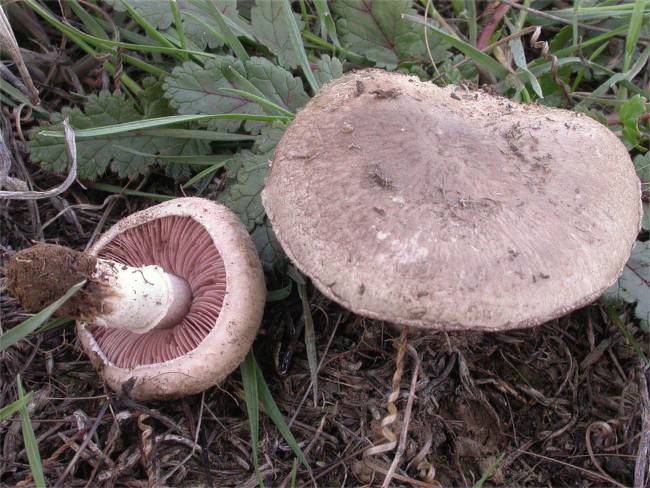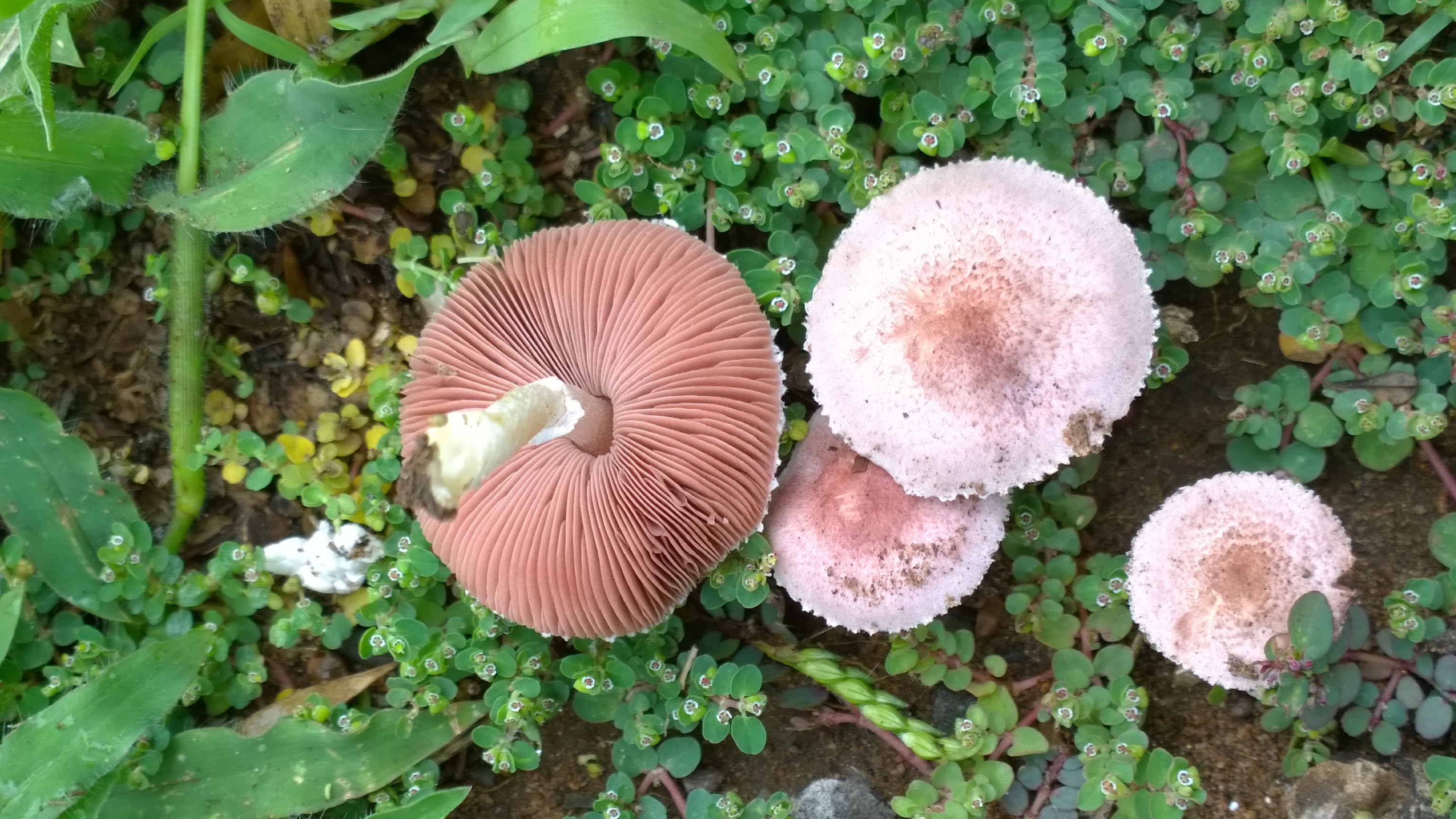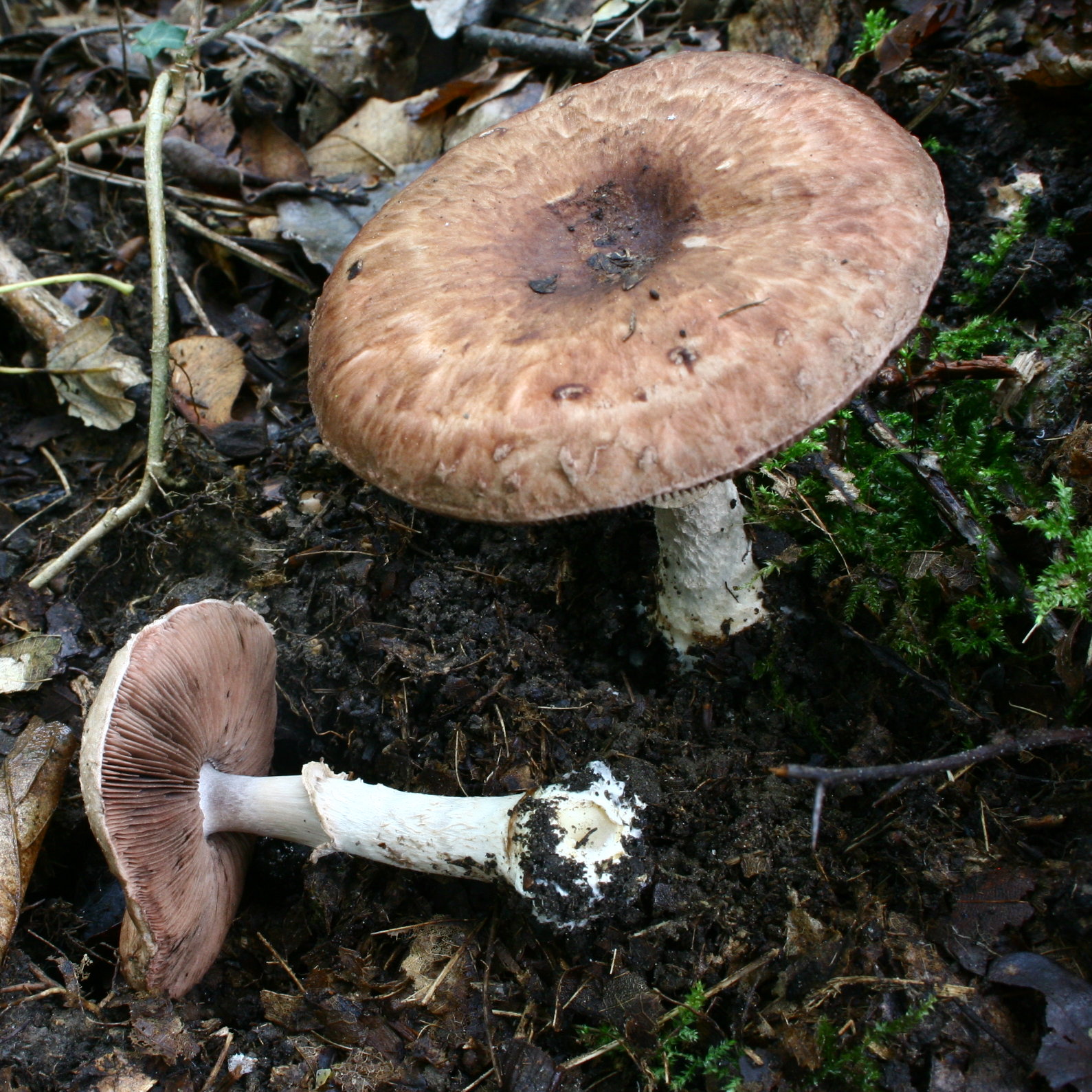Agaricus on:
[Wikipedia]
[Google]
[Amazon]
''Agaricus'' is a
 Subgenus '' Agaricus''
* Section ''Agaricus''
:This is the group around the
Subgenus '' Agaricus''
* Section ''Agaricus''
:This is the group around the  Subgenus '' Flavoagaricus''
* Section ''Arvense'' Konrad & Maubl. (sometimes named ''Arvensis'')
:Traditionally contained about 20 rather large species similar to the horse mushroom '' A. arvensis'' in six subgroups. Today, several additional species are recognized – in particular in the ''A. arvensis''
Subgenus '' Flavoagaricus''
* Section ''Arvense'' Konrad & Maubl. (sometimes named ''Arvensis'')
:Traditionally contained about 20 rather large species similar to the horse mushroom '' A. arvensis'' in six subgroups. Today, several additional species are recognized – in particular in the ''A. arvensis'' 
 Subgenus '' Minores''
:A group of buff-white to reddish-brown species. Often delicate and slender, the typical members of this subgenus do not resemble the larger ''Agaricus'' species at a casual glance, but have the same telltale chocolate-brown gills at spore maturity. Their flesh has a barely noticeable to pronounced sweetish smell, typically
Subgenus '' Minores''
:A group of buff-white to reddish-brown species. Often delicate and slender, the typical members of this subgenus do not resemble the larger ''Agaricus'' species at a casual glance, but have the same telltale chocolate-brown gills at spore maturity. Their flesh has a barely noticeable to pronounced sweetish smell, typically 

 Subgenus '' Pseudochitonia''
:This highly diverse clade of mid-sized to largish species makes up much the bulk of the genus' extant diversity, and this subgenus contains numerous as of yet undescribed species. It includes both the most prized edible as well as the most notoriously poisonous ''Agaricus'', and some of its sections are in overall appearance more similar to the more distantly related ''Agaricus'' proper and ''Flavoagaricus'' than to their own closest relatives. Some species in this subgenus, such as '' A. goossensiae'' and '' A. rodmanii'', are not yet robustly assigned to one of the sections.
* Section '' Bohusia''
:Includes '' A. bohusii'' which resembles one of the dark-capped ''Flavoagaricus'' or ''Xanthodermatei'' but does not stain yellow with the standard (10%) KOH testing solution. It is a woodland species, edible when young, but when mature and easily distinguished from similar species it may be slightly poisonous. Other members of this section include '' A. crassisquamosus'', '' A. haematinus'', and '' A. pseudolangei''.
* Section '' Brunneopicti''
:A section notable for containing a considerable number of undescribed species in addition to '' A. bingensis'', '' A. brunneopictus'', '' A. brunneosquamulosus'', '' A. chiangmaiensis'', '' A. duplocingulatus'', '' A. megacystidiatus'', '' A. niveogranulatus'', '' A. sordidocarpus'', '' A. subsaharianus'', and '' A. toluenolens''.
* Section '' Chitonioides''
:Contains species such as '' A. bernardii'' and the doubtfully distinct '' A. bernardiiformis'', '' A. gennadii'', '' A. nevoi'', '' A. pequinii'', '' A. pilosporus'' and '' A. rollanii'', which strongly resemble the members of section ''Duploannulatae'' and are as widely distributed. However, their flesh tends to discolor more strongly red when bruised or cut, with the discoloration slowly getting stronger. Their smell is usually also more pronounced umami-like, in some even intensely so. Some are edible and indeed considered especially well-tasting, while the unusual '' A. maleolens'' which may also belong here has an overpowering aroma which renders it inedible except perhaps in small amounts as a vegan
Subgenus '' Pseudochitonia''
:This highly diverse clade of mid-sized to largish species makes up much the bulk of the genus' extant diversity, and this subgenus contains numerous as of yet undescribed species. It includes both the most prized edible as well as the most notoriously poisonous ''Agaricus'', and some of its sections are in overall appearance more similar to the more distantly related ''Agaricus'' proper and ''Flavoagaricus'' than to their own closest relatives. Some species in this subgenus, such as '' A. goossensiae'' and '' A. rodmanii'', are not yet robustly assigned to one of the sections.
* Section '' Bohusia''
:Includes '' A. bohusii'' which resembles one of the dark-capped ''Flavoagaricus'' or ''Xanthodermatei'' but does not stain yellow with the standard (10%) KOH testing solution. It is a woodland species, edible when young, but when mature and easily distinguished from similar species it may be slightly poisonous. Other members of this section include '' A. crassisquamosus'', '' A. haematinus'', and '' A. pseudolangei''.
* Section '' Brunneopicti''
:A section notable for containing a considerable number of undescribed species in addition to '' A. bingensis'', '' A. brunneopictus'', '' A. brunneosquamulosus'', '' A. chiangmaiensis'', '' A. duplocingulatus'', '' A. megacystidiatus'', '' A. niveogranulatus'', '' A. sordidocarpus'', '' A. subsaharianus'', and '' A. toluenolens''.
* Section '' Chitonioides''
:Contains species such as '' A. bernardii'' and the doubtfully distinct '' A. bernardiiformis'', '' A. gennadii'', '' A. nevoi'', '' A. pequinii'', '' A. pilosporus'' and '' A. rollanii'', which strongly resemble the members of section ''Duploannulatae'' and are as widely distributed. However, their flesh tends to discolor more strongly red when bruised or cut, with the discoloration slowly getting stronger. Their smell is usually also more pronounced umami-like, in some even intensely so. Some are edible and indeed considered especially well-tasting, while the unusual '' A. maleolens'' which may also belong here has an overpowering aroma which renders it inedible except perhaps in small amounts as a vegan  Subgenus '' Spissicaules''
:The flesh of members of this subgenus tends to turn more or less pronouncedly yellowish in the lower stalk, where the skin is often rough and scaly, and reddish in the cap. They typically resemble the darker members of subgenus ''Flavoagaricus'', with a sweet smell and mild taste; like that subgenus, ''Spissicaules'' belongs to the smaller of the two main groups of the genus, but they form entirely different branch therein. While some species are held to be edible, others are considered unappetizing or even slightly poisonous. Also includes '' A. lanipes'' and '' A. maskae'', which probably belong to section ''Rarolentes'' or ''Spissicaules'', and possibly also '' A. bresadolanus'' and its doubtfully distinct relatives '' A. radicatus''/'' romagnesii''.
* Section '' Amoeni''
:Includes '' A. amoenus'' and '' A. gratolens''.
* Section '' Rarolentes''
:Includes '' A. albosquamosus'' and '' A. leucolepidotus''.
* Section '' Spissicaules'' ( Hainem.) Kerrigan
:Includes species such as '' A. leucotrichus''/'' litoralis'' (of which ''A. spissicaulis'' is a synonym, but see also Geml ''et al.'' 2004) and '' A. litoraloides''. Most significantly, some species have a persistent and unpleasant rotting-wood smell entirely unlike the sweet aroma of ''Flavoagaricus'', and while not known to be poisonous, are certainly unpalatable.
* Section '' Subrutilescentes''
:Includes '' A. brunneopilatus'', '' A. linzhinensis'' and '' A. subrutilescens''. Somewhat similar to section ''Sanguinolenti'' or the dark-capped species of section ''Xanthodermatei'', but the flesh does not show a pronounced red or yellow color change when cut or bruised. Edibility is disputed.
Subgenus '' Spissicaules''
:The flesh of members of this subgenus tends to turn more or less pronouncedly yellowish in the lower stalk, where the skin is often rough and scaly, and reddish in the cap. They typically resemble the darker members of subgenus ''Flavoagaricus'', with a sweet smell and mild taste; like that subgenus, ''Spissicaules'' belongs to the smaller of the two main groups of the genus, but they form entirely different branch therein. While some species are held to be edible, others are considered unappetizing or even slightly poisonous. Also includes '' A. lanipes'' and '' A. maskae'', which probably belong to section ''Rarolentes'' or ''Spissicaules'', and possibly also '' A. bresadolanus'' and its doubtfully distinct relatives '' A. radicatus''/'' romagnesii''.
* Section '' Amoeni''
:Includes '' A. amoenus'' and '' A. gratolens''.
* Section '' Rarolentes''
:Includes '' A. albosquamosus'' and '' A. leucolepidotus''.
* Section '' Spissicaules'' ( Hainem.) Kerrigan
:Includes species such as '' A. leucotrichus''/'' litoralis'' (of which ''A. spissicaulis'' is a synonym, but see also Geml ''et al.'' 2004) and '' A. litoraloides''. Most significantly, some species have a persistent and unpleasant rotting-wood smell entirely unlike the sweet aroma of ''Flavoagaricus'', and while not known to be poisonous, are certainly unpalatable.
* Section '' Subrutilescentes''
:Includes '' A. brunneopilatus'', '' A. linzhinensis'' and '' A. subrutilescens''. Somewhat similar to section ''Sanguinolenti'' or the dark-capped species of section ''Xanthodermatei'', but the flesh does not show a pronounced red or yellow color change when cut or bruised. Edibility is disputed.
 As late as 2008, ''Agaricus'' was believed to contain about 200 species worldwide but since then,
As late as 2008, ''Agaricus'' was believed to contain about 200 species worldwide but since then,  '' Agaricus abruptibulbus'' – abruptly-bulbous agaricus, flat-bulb mushroom (disputed)
*
'' Agaricus abruptibulbus'' – abruptly-bulbous agaricus, flat-bulb mushroom (disputed)
*  '' Agaricus aestivalis''
* '' Agaricus agrinferus'' (disputed)
* '' Agaricus alabamensis''
*
'' Agaricus aestivalis''
* '' Agaricus agrinferus'' (disputed)
* '' Agaricus alabamensis''
*  '' Agaricus albolutescens'' (disputed)
* '' Agaricus alligator''
*
'' Agaricus albolutescens'' (disputed)
* '' Agaricus alligator''
*  '' Agaricus amicosus''
* '' Agaricus angusticystidiatus''
* '' Agaricus annae''
* '' Agaricus arorae''
*
'' Agaricus amicosus''
* '' Agaricus angusticystidiatus''
* '' Agaricus annae''
* '' Agaricus arorae''
*  '' Agaricus arvensis'' – horse mushroom
*
'' Agaricus arvensis'' – horse mushroom
*  '' Agaricus augustus'' – the prince
*
'' Agaricus augustus'' – the prince
*  '' Agaricus aurantioviolaceus''
* '' Agaricus benesii''
*
'' Agaricus aurantioviolaceus''
* '' Agaricus benesii''
*  '' Agaricus bernardii'' – salt-loving mushroom
*
'' Agaricus bernardii'' – salt-loving mushroom
*  '' Agaricus bisporus'' – cultivated/button/portobello mushroom (includes ''A.brunnescens'')
*
'' Agaricus bisporus'' – cultivated/button/portobello mushroom (includes ''A.brunnescens'')
*  '' Agaricus bitorquis'' – pavement mushroom, banded agaric
* '' Agaricus braendlei''
* '' Agaricus bresadolanus''
*
'' Agaricus bitorquis'' – pavement mushroom, banded agaric
* '' Agaricus braendlei''
* '' Agaricus bresadolanus''
*  '' Agaricus brunneofibrillosus'' (formerly in ''A.fuscofibrillosus'')
*
'' Agaricus brunneofibrillosus'' (formerly in ''A.fuscofibrillosus'')
*  '' Agaricus californicus'' – California agaricus
*
'' Agaricus californicus'' – California agaricus
*  '' Agaricus campestris'' – field/meadow mushroom
* '' Agaricus columellatus'' (formerly in ''Araneosa'')
*
'' Agaricus campestris'' – field/meadow mushroom
* '' Agaricus columellatus'' (formerly in ''Araneosa'')
*  '' Agaricus cupreobrunneus'' – brown field mushroom
*
'' Agaricus cupreobrunneus'' – brown field mushroom
*  '' Agaricus deserticola'' G.Moreno, Esqueda & Lizárraga (2010) – gasteroid agaricus (formerly in ''Longula'')
*
'' Agaricus deserticola'' G.Moreno, Esqueda & Lizárraga (2010) – gasteroid agaricus (formerly in ''Longula'')
*  '' Agaricus dulcidulus'' – rosy wood mushroom (sometimes in ''A.semotus'')
*
'' Agaricus dulcidulus'' – rosy wood mushroom (sometimes in ''A.semotus'')
*  '' Agaricus excellens'' (disputed)
* '' Agaricus freirei''
*
'' Agaricus excellens'' (disputed)
* '' Agaricus freirei''
*  '' Agaricus hondensis'' – felt-ringed agaricus
*
'' Agaricus hondensis'' – felt-ringed agaricus
*  '' Agaricus impudicus'' – tufted wood mushroom
* '' Agaricus inapertus'' (formerly in ''Endoptychum'')
* '' Agaricus julius''
* '' Agaricus lanatoniger''
* '' Agaricus langei'' (= ''A.fuscofibrillosus'')
*
'' Agaricus impudicus'' – tufted wood mushroom
* '' Agaricus inapertus'' (formerly in ''Endoptychum'')
* '' Agaricus julius''
* '' Agaricus lanatoniger''
* '' Agaricus langei'' (= ''A.fuscofibrillosus'')
*  '' Agaricus lilaceps'' – giant cypress agaricus
* '' Agaricus litoralis'' – coastal mushroom (includes ''A.spissicaulis'')
*
'' Agaricus lilaceps'' – giant cypress agaricus
* '' Agaricus litoralis'' – coastal mushroom (includes ''A.spissicaulis'')
*  '' Agaricus macrosporus'' (disputed)
*
'' Agaricus macrosporus'' (disputed)
*  '' Agaricus moelleri'' – inky/dark-scaled mushroom (formerly in ''A.placomyces'', includes ''A.meleagris'')
* '' Agaricus nebularum''
*
'' Agaricus moelleri'' – inky/dark-scaled mushroom (formerly in ''A.placomyces'', includes ''A.meleagris'')
* '' Agaricus nebularum''
*  '' Agaricus pattersoniae''
*
'' Agaricus pattersoniae''
*  '' Agaricus perobscurus'' – American princess
*
'' Agaricus perobscurus'' – American princess
*  '' Agaricus phaeolepidotus''
*
'' Agaricus phaeolepidotus''
*  '' Agaricus pilatianus''
*
'' Agaricus pilatianus''
*  '' Agaricus placomyces'' (includes ''A.praeclaresquamosus'')
*
'' Agaricus placomyces'' (includes ''A.praeclaresquamosus'')
*  '' Agaricus pocillator''
*
'' Agaricus pocillator''
*  '' Agaricus santacatalinensis''
*
'' Agaricus santacatalinensis''
*  '' Agaricus semotus''
*
'' Agaricus semotus''
*  '' Agaricus silvaticus'' – scaly/blushing wood mushroom, pinewood mushroom (= ''A.sylvaticus'', includes ''A.haemorrhoidarius'')
*
'' Agaricus silvaticus'' – scaly/blushing wood mushroom, pinewood mushroom (= ''A.sylvaticus'', includes ''A.haemorrhoidarius'')
*  '' Agaricus silvicola'' – wood mushroom (= ''A.sylvicola'')
*
'' Agaricus silvicola'' – wood mushroom (= ''A.sylvicola'')
*  '' Agaricus subrufescens'' (includes ''A.rufotegulis'', often confused with ''A.blazei'' and ''A.brasiliensis'') – almond mushroom, royal sun agaricus, and various fanciful names
*
'' Agaricus subrufescens'' (includes ''A.rufotegulis'', often confused with ''A.blazei'' and ''A.brasiliensis'') – almond mushroom, royal sun agaricus, and various fanciful names
*  '' Agaricus subrutilescens'' – wine-colored agaricus
* '' Agaricus taeniatus''
*
'' Agaricus subrutilescens'' – wine-colored agaricus
* '' Agaricus taeniatus''
*  '' Agaricus urinascens''
*
'' Agaricus urinascens''
*  '' Agaricus xanthodermus'' – yellow-staining mushroom
'' Agaricus xanthodermus'' – yellow-staining mushroom
 A notable group of poisonous ''Agaricus'' is the
A notable group of poisonous ''Agaricus'' is the
Mushroom Expert - The Genus Agaricus
{{Authority control Agaricales genera Taxa named by Carl Linnaeus Taxa described in 1753
genus
Genus (; : genera ) is a taxonomic rank above species and below family (taxonomy), family as used in the biological classification of extant taxon, living and fossil organisms as well as Virus classification#ICTV classification, viruses. In bino ...
of mushroom
A mushroom or toadstool is the fleshy, spore-bearing Sporocarp (fungi), fruiting body of a fungus, typically produced above ground on soil or another food source. ''Toadstool'' generally refers to a poisonous mushroom.
The standard for the n ...
-forming fungi
A fungus (: fungi , , , or ; or funguses) is any member of the group of eukaryotic organisms that includes microorganisms such as yeasts and mold (fungus), molds, as well as the more familiar mushrooms. These organisms are classified as one ...
containing both edible and poisonous species, with over 400 members worldwide and possibly again as many disputed or newly discovered species. The genus includes the common ("button") mushroom ('' A. bisporus'') and the field mushroom ('' A. campestris''), the dominant cultivated mushrooms of the West.
Taxonomy
Several origins of genus name ''Agaricus'' have been proposed. It possibly originates from ancient Sarmatia Europaea, where people Agari, promontory Agarum and a river Agarus were known (all located on the northern shore ofSea of Azov
The Sea of Azov is an inland Continental shelf#Shelf seas, shelf sea in Eastern Europe connected to the Black Sea by the narrow (about ) Strait of Kerch, and sometimes regarded as a northern extension of the Black Sea. The sea is bounded by Ru ...
, probably, near modern Berdiansk
Berdiansk or Berdyansk (, ; , ) is a port city in Zaporizhzhia Oblast, south-eastern Ukraine. It is on the northern coast of the Sea of Azov, which is connected to the Black Sea. It serves as the administrative center of Berdiansk Raion. The c ...
in Ukraine).
Note also Greek , agarikón, "a sort of tree fungus" (There has been an ''Agaricon'' Adans. genus, treated by Donk in ''Persoonia'' 1:180.)
For many years, members of the genus ''Agaricus'' were given the generic name ''Psalliota'', and this can still be seen in older books on mushrooms. All proposals to conserve ''Agaricus'' against ''Psalliota'' or vice versa have so far been considered superfluous.
Dok reports Carl Linnaeus
Carl Linnaeus (23 May 1707 – 10 January 1778), also known after ennoblement in 1761 as Carl von Linné,#Blunt, Blunt (2004), p. 171. was a Swedish biologist and physician who formalised binomial nomenclature, the modern system of naming o ...
' name is devalidated (so the proper author citation apparently is "L. ''per'' Fr., 1821") because ''Agaricus'' was not linked to Tournefort's name. Linnaeus places both ''Agaricus'' Dill. and ''Amanita'' Dill. in synonymy, but truly a replacement for ''Amanita'' Dill., which would require ''A. quercinus'', not ''A. campestris'' be the type. This question is compounded because Elias Magnus Fries
Elias Magnus Fries (15 August 1794 – 8 February 1878) was a Swedish mycologist and botanist. He is sometimes called the Mycology, "Linnaeus of Mycology". In his works he described and assigned botanical names to hundreds of fungus and li ...
himself used ''Agaricus'' roughly in Linnaeus' sense (which leads to issues with ''Amanita''), and ''A. campestris'' was eventually excluded from ''Agaricus'' by Karsten and was apparently in ''Lepiota'' at the time Donk wrote this, commenting that a type conservation might become necessary.
The alternate name for the genus, ''Psalliota'', derived from the Greek ''psalion''/ψάλιον, "ring", was first published by Fries (1821) as trib. ''Psalliota''. The type is '' Agaricus campestris'' (widely accepted, except by Earle, who proposed ''A. cretaceus''). Paul Kummer (not Quélet, who merely excluded Stropharia) was the first to elevate the tribe to a genus. ''Psalliota'' was the tribe containing the type of ''Agaricus'', so when separated, it should have caused the rest of the genus to be renamed, but this is not what happened.
Phylogeny
The use ofphylogenetic
In biology, phylogenetics () is the study of the evolutionary history of life using observable characteristics of organisms (or genes), which is known as phylogenetic inference. It infers the relationship among organisms based on empirical dat ...
analysis to determine evolutionary relationships amongst ''Agaricus'' species has increased the understanding of this taxonomically difficult genus, although much work remains to be done to fully delineate infrageneric relationships. Prior to these analyses, the genus ''Agaricus'', as circumscribed by Rolf Singer
Rolf Singer (June 23, 1906 – January 18, 1994) was a German mycologist and Taxonomy (biology), taxonomist of gilled mushrooms (agarics).
He wrote the book "The Agaricales in Modern Taxonomy (biology), Taxonomy". He fled to various countries d ...
, was divided into 42 species grouped into five sections based on reactions of mushroom tissue to air or various chemical reagents, as well as subtle differences in mushroom morphology. Restriction fragment length polymorphism analysis demonstrated this classification scheme needed revision.
Subdivisions
As of 2018, this genus is divided into 6subgenera
In biology, a subgenus ( subgenera) is a taxonomic rank directly below genus.
In the International Code of Zoological Nomenclature, a subgeneric name can be used independently or included in a species name, in parentheses, placed between the ge ...
and more than 20 sections: Bon, Marcel (1987) ''The Mushrooms and Toadstools of Britain and North Western Europe''. Hodder and Stoughton, (paperback) (hardback)
 Subgenus '' Agaricus''
* Section ''Agaricus''
:This is the group around the
Subgenus '' Agaricus''
* Section ''Agaricus''
:This is the group around the type species
In International_Code_of_Zoological_Nomenclature, zoological nomenclature, a type species (''species typica'') is the species name with which the name of a genus or subgenus is considered to be permanently taxonomically associated, i.e., the spe ...
of the genus, the popular edible '' A. campestris'' which is common across the Holarctic
The Holarctic realm is a biogeographic realm that comprises the majority of habitats found throughout the continents in the Northern Hemisphere. It corresponds to the floristic Boreal Kingdom. It includes both the Nearctic zoogeographical reg ...
temperate zone
In geography, the temperate climates of Earth occur in the middle latitudes (approximately 23.5° to 66.5° N/S of the Equator), which span between the tropics and the polar regions of Earth. These zones generally have wider temperature ra ...
, and has been introduced to some other regions. One of the more ancient lineages of the genus, it contains species typically found in open grassland such as '' A. cupreobrunneus'', and it also includes at least one undescribed species. Their cap surface is whitish to pale reddish-brown and smooth to slightly fibrous, the flesh usually without characteristic smell, fairly soft, whitish, and remaining so after injury, application of KOH, or Schäffer's test ( aniline and HNO3). '' A. annae'' may also belong here, as might '' A. porphyrocephalus'', but the flesh of the latter blushes red when bruised or cut, and it has an unpleasant smell of rotten fish when old; these traits are generally associated with subgenus ''Pseudochitonia'', in particular section ''Chitonioides''. The '' A. bresadolanus/ radicatus/ romagnesii'' group which may be one or several species is sometimes placed here, but may be quite distinct and belong to subgenus ''Spissicaules''.
 Subgenus '' Flavoagaricus''
* Section ''Arvense'' Konrad & Maubl. (sometimes named ''Arvensis'')
:Traditionally contained about 20 rather large species similar to the horse mushroom '' A. arvensis'' in six subgroups. Today, several additional species are recognized – in particular in the ''A. arvensis''
Subgenus '' Flavoagaricus''
* Section ''Arvense'' Konrad & Maubl. (sometimes named ''Arvensis'')
:Traditionally contained about 20 rather large species similar to the horse mushroom '' A. arvensis'' in six subgroups. Today, several additional species are recognized – in particular in the ''A. arvensis'' species complex
In biology, a species complex is a group of closely related organisms that are so similar in appearance and other features that the boundaries between them are often unclear. The taxa in the complex may be able to hybridize readily with each oth ...
and placed here, such as '' A. aestivalis'', '' A. augustus'', '' A. caroli'', '' A. chionodermus'', '' A. deserticola'' (formerly ''Longula texensis''), '' A. fissuratus'', '' A. inapertus'' (formerly '' Endoptychum depressum''), '' A. macrocarpus'', '' A. nivescens'', '' A. osecanus'', '' A. silvicola'' and the doubtfully distinct '' A. essettei'', '' A. urinascens'', and the disputed taxa '' A. abruptibulbus'', '' A. albertii'', '' A. altipes'', '' A. albolutescens'', '' A. brunneolus'', '' A. excellens'' and '' A. macrosporus''. It also includes '' A. subrufescens'' which started to be widely grown and traded under various obsolete and newly-invented names in the early 21st century, as well as the Florida
Florida ( ; ) is a U.S. state, state in the Southeastern United States, Southeastern region of the United States. It borders the Gulf of Mexico to the west, Alabama to the northwest, Georgia (U.S. state), Georgia to the north, the Atlantic ...
n '' A. blazei'' with which the Brazil
Brazil, officially the Federative Republic of Brazil, is the largest country in South America. It is the world's List of countries and dependencies by area, fifth-largest country by area and the List of countries and dependencies by population ...
ian ''A. subrufescens'' was often confused in the past. They have versatile heterothallic life cycles, are found in a variety of often rather arid habitats, and typically have a smooth white to scaly light brown cap. The flesh, when bruised, usually turns distinctly yellow to pinkish in particular on the cap, while the end of the stalk may remain white; a marked yellow stain is caused by applying KOH. Their sweetish smell of almond extract or marzipan due to benzaldehyde and derived compounds distinguishes them from the section ''Xanthodermatei'', as does a bright dark-orange to brownish-red coloration in Schäffer's test. Many members of this subgenus are highly regarded as food, and even medically beneficial, but at least some are known to accumulate cadmium and other highly toxic chemicals from the environment, and may not always be safe to eat.

 Subgenus '' Minores''
:A group of buff-white to reddish-brown species. Often delicate and slender, the typical members of this subgenus do not resemble the larger ''Agaricus'' species at a casual glance, but have the same telltale chocolate-brown gills at spore maturity. Their flesh has a barely noticeable to pronounced sweetish smell, typically
Subgenus '' Minores''
:A group of buff-white to reddish-brown species. Often delicate and slender, the typical members of this subgenus do not resemble the larger ''Agaricus'' species at a casual glance, but have the same telltale chocolate-brown gills at spore maturity. Their flesh has a barely noticeable to pronounced sweetish smell, typically almond
The almond (''Prunus amygdalus'', Synonym (taxonomy)#Botany, syn. ''Prunus dulcis'') is a species of tree from the genus ''Prunus''. Along with the peach, it is classified in the subgenus ''Amygdalus'', distinguished from the other subgenera ...
-like, turns yellowish to brownish-red when cut or bruised at least in the lower stalk, yellow to orange with KOH, and orange to red in Schäffer's test. Species such as '' A. aridicola'' (formerly known as '' Gyrophragmium dunalii''), '' A. colpeteii'', '' A. columellatus'' (formerly ''Araneosa columellata''), '' A. diminutivus'', '' A. dulcidulus'', '' A. lamelliperditus'', '' A. luteomaculatus'', '' A. porphyrizon'', '' A. semotus'' and '' A. xantholepis'' are included here, but delimitation to and indeed distinctness from subgenus ''Flavoagaricus'' is a long-standing controversy. Unlike these however, subgenus ''Minores'' contains no choice edible species, and may even include some slightly poisonous ones; most are simply too small to make collecting them for food worthwhile, and their edibility is unknown.
* Section '' Leucocarpi''
:Includes '' A. leucocarpus''.
* Section '' Minores''
:Includes '' A. comtulus'' and '' A. huijsmanii''.
* Section '' Pantropicales''
:Includes '' A. candidolutescens'' and an undescribed relative.
Subgenus '' Minoriopsis''
:Somewhat reminiscent of subgenus ''Minores'' and like it closely related to subgenus ''Flavoagaricus'', it contains species such as '' A. martinicensis'' and '' A. rufoaurantiacus''.


 Subgenus '' Pseudochitonia''
:This highly diverse clade of mid-sized to largish species makes up much the bulk of the genus' extant diversity, and this subgenus contains numerous as of yet undescribed species. It includes both the most prized edible as well as the most notoriously poisonous ''Agaricus'', and some of its sections are in overall appearance more similar to the more distantly related ''Agaricus'' proper and ''Flavoagaricus'' than to their own closest relatives. Some species in this subgenus, such as '' A. goossensiae'' and '' A. rodmanii'', are not yet robustly assigned to one of the sections.
* Section '' Bohusia''
:Includes '' A. bohusii'' which resembles one of the dark-capped ''Flavoagaricus'' or ''Xanthodermatei'' but does not stain yellow with the standard (10%) KOH testing solution. It is a woodland species, edible when young, but when mature and easily distinguished from similar species it may be slightly poisonous. Other members of this section include '' A. crassisquamosus'', '' A. haematinus'', and '' A. pseudolangei''.
* Section '' Brunneopicti''
:A section notable for containing a considerable number of undescribed species in addition to '' A. bingensis'', '' A. brunneopictus'', '' A. brunneosquamulosus'', '' A. chiangmaiensis'', '' A. duplocingulatus'', '' A. megacystidiatus'', '' A. niveogranulatus'', '' A. sordidocarpus'', '' A. subsaharianus'', and '' A. toluenolens''.
* Section '' Chitonioides''
:Contains species such as '' A. bernardii'' and the doubtfully distinct '' A. bernardiiformis'', '' A. gennadii'', '' A. nevoi'', '' A. pequinii'', '' A. pilosporus'' and '' A. rollanii'', which strongly resemble the members of section ''Duploannulatae'' and are as widely distributed. However, their flesh tends to discolor more strongly red when bruised or cut, with the discoloration slowly getting stronger. Their smell is usually also more pronounced umami-like, in some even intensely so. Some are edible and indeed considered especially well-tasting, while the unusual '' A. maleolens'' which may also belong here has an overpowering aroma which renders it inedible except perhaps in small amounts as a vegan
Subgenus '' Pseudochitonia''
:This highly diverse clade of mid-sized to largish species makes up much the bulk of the genus' extant diversity, and this subgenus contains numerous as of yet undescribed species. It includes both the most prized edible as well as the most notoriously poisonous ''Agaricus'', and some of its sections are in overall appearance more similar to the more distantly related ''Agaricus'' proper and ''Flavoagaricus'' than to their own closest relatives. Some species in this subgenus, such as '' A. goossensiae'' and '' A. rodmanii'', are not yet robustly assigned to one of the sections.
* Section '' Bohusia''
:Includes '' A. bohusii'' which resembles one of the dark-capped ''Flavoagaricus'' or ''Xanthodermatei'' but does not stain yellow with the standard (10%) KOH testing solution. It is a woodland species, edible when young, but when mature and easily distinguished from similar species it may be slightly poisonous. Other members of this section include '' A. crassisquamosus'', '' A. haematinus'', and '' A. pseudolangei''.
* Section '' Brunneopicti''
:A section notable for containing a considerable number of undescribed species in addition to '' A. bingensis'', '' A. brunneopictus'', '' A. brunneosquamulosus'', '' A. chiangmaiensis'', '' A. duplocingulatus'', '' A. megacystidiatus'', '' A. niveogranulatus'', '' A. sordidocarpus'', '' A. subsaharianus'', and '' A. toluenolens''.
* Section '' Chitonioides''
:Contains species such as '' A. bernardii'' and the doubtfully distinct '' A. bernardiiformis'', '' A. gennadii'', '' A. nevoi'', '' A. pequinii'', '' A. pilosporus'' and '' A. rollanii'', which strongly resemble the members of section ''Duploannulatae'' and are as widely distributed. However, their flesh tends to discolor more strongly red when bruised or cut, with the discoloration slowly getting stronger. Their smell is usually also more pronounced umami-like, in some even intensely so. Some are edible and indeed considered especially well-tasting, while the unusual '' A. maleolens'' which may also belong here has an overpowering aroma which renders it inedible except perhaps in small amounts as a vegan fish sauce
Fish sauce is a liquid condiment made from fish or krill that have been coated in salt and fermented for up to two years. It is used as a staple seasoning in East Asian cuisine and Southeast Asian cuisine, particularly Myanmar, Cambodia, L ...
substitute.
* Section '' Crassispori''
:Related to section ''Xanthodermatei'' as traditionally circumscribed, it includes such species as '' A. campestroides'', '' A. lamellidistans'', and '' A. variicystis''.
* Section '' Cymbiformes'' He, Chuankid, Hyde, Cheewangkoon & Zhao
:A section proposed in 2018, it is closely related to the traditional section ''Xanthodermatei''. The type species '' A. angusticystidiatus'' from Thailand
Thailand, officially the Kingdom of Thailand and historically known as Siam (the official name until 1939), is a country in Southeast Asia on the Mainland Southeast Asia, Indochinese Peninsula. With a population of almost 66 million, it spa ...
is a smallish beige ''Agaricus'' with characteristic boat-shaped basidiospores. It has a strong unpleasant smell like members of section ''Xanthodermatei'', but unlike these, its flesh does not change color when bruised, but turns dark reddish-brown when cut, and neither application of KOH nor Schäffer's test elicit a change in color.
* Section '' Duploannulatae'' (also known as section '' Bivelares'' or '' Hortenses'')
:Traditionally often included in section ''Agaricus'' as subsection ''Bitorques'', it seems to belong to a much younger radiation. It unites robust species, usually with a thick, almost fleshy ring, which inhabit diverse but often nutrient-rich locations. Some are well-known edibles; as they are frequently found along roads and in similar polluted places, they may not be safe to eat if collected from the wild. Their flesh is rather firm, white, with no characteristic smell, in some species turning markedly reddish when bruised or cut (though this may soon fade again), and generally changing color barely if at all after application of KOH or Schäffer's test. Based on DNA analysis of ITS1, ITS2, and 5.8S sequences, the studied species of this section could be divided into six distinct clades, four of which correspond to well-known species from the temperate
In geography, the temperate climates of Earth occur in the middle latitudes (approximately 23.5° to 66.5° N/S of the Equator), which span between the tropics and the polar regions of Earth. These zones generally have wider temperature ran ...
Northern Hemisphere: '' A. bisporus'', '' A. bitorquis'' (and the doubtfully distinct '' A. edulis''), '' A. cupressicola'' and '' A. vaporarius''. The other two clades comprise the '' A. devoniensis'' (including '' A. subperonatus'') and '' A. subfloccosus'' (including '' A. agrinferus'') species complex
In biology, a species complex is a group of closely related organisms that are so similar in appearance and other features that the boundaries between them are often unclear. The taxa in the complex may be able to hybridize readily with each oth ...
es. Additional members of this section not included in that study are '' A. cappellianus'', '' A. cupressophilus'', '' A. subsubensis'', '' A. taeniatus'', '' A. tlaxcalensis'', and at least one undescribed species. The cultivated mushrooms traded as '' A. sinodeliciosus'' also belong here, though their relationship to the ''A. devoniensis'' complex and ''A. vaporarius'' is unclear.
* Section '' Flocculenti''
:Includes '' A. erectosquamosus'' and '' A. pallidobrunneus''; a more distant undescribed relative of these two may also belong in this section.
* Section '' Hondenses'' (disputed)
:Traditionally included in section ''Xanthodermatei'' '' sensu lato'', this clade may be included therein as the most basal branch, or considered a section in its own right. It includes such species as '' A. biannulatus'', '' A. freirei'' and its North American relatives '' A. grandiomyces'', '' A. hondensis'', and probably also '' A. phaeolepidotus''. They are very similar to section ''Xanthodermatei'' '' sensu stricto'' in all aspects, except for a weaker discoloration tending towards reddish rather than chrome yellow when bruised.
* Section '' Nigrobrunnescentes''
:Includes '' A. biberi'', '' A. caballeroi'', '' A. desjardinii'', '' A. erythrosarx'', '' A. fuscovelatus'', '' A. nigrobrunnescens'', '' A. padanus'', '' A. pattersoniae'', and probably also '' A. boisseletii''.
* Section '' Rubricosi''
:Includes '' A. dolichopus'', '' A. kunmingensis'', '' A. magnivelaris'', '' A. variabilicolor'', and at least two undescribed species.
* Section '' Sanguinolenti''
:Usually found in woodland. Brownish cap with a fibrous surface, typically felt-like but sometimes scaly. The fairly soft flesh turns pink, blood-red or orange when cut or scraped, in particular the outer layer of the stalk, but does not change color after application of KOH or Schäffer's test. Some North American species traditionally placed here, such as '' A. amicosus'' and '' A. brunneofibrillosus'', do not seem to be closely related to the section's type species '' A. silvaticus'' (including ''A. haemorrhoidarius'' which is sometimes considered a distinct species), and represent at least a distinct subsection. Other species often placed in this section are '' A. benesii'', '' A. dilutibrunneus'', '' A. impudicus'', '' A. koelerionensis'', '' A. langei'' and '' A. variegans''; not all of these may actually belong here. They are generally (though not invariably) regarded as edible and tasty.
* Section '' Trisulphurati'' (disputed)
:Includes the '' A. trisulphuratus'' species complex which is often placed in genus '' Cystoagaricus'', but seems to be a true ''Agaricus'' closely related to the traditional section ''Xanthodermatei''. Their stalk is typically bright yellow-orange, quite unlike that of other ''Agaricus'', as is the scaly cap. ''A. trisulphuratus'' was the type species of the obsolete polyphyletic
A polyphyletic group is an assemblage that includes organisms with mixed evolutionary origin but does not include their most recent common ancestor. The term is often applied to groups that share similar features known as Homoplasy, homoplasies ...
subgenus ''Lanagaricus'', whose former species are now placed in various other sections.
* Section '' Xanthodermatei''
:As outlined by Singer in 1948, this section includes species with various characteristics similar to the type species '' A. xanthodermus''. The section forms a single clade
In biology, a clade (), also known as a Monophyly, monophyletic group or natural group, is a group of organisms that is composed of a common ancestor and all of its descendants. Clades are the fundamental unit of cladistics, a modern approach t ...
based on analysis of ITS1+2. They are either bright white all over, or have a cap densely flecked with brownish scales or tufts of fibers. The ring is usually large but thin and veil-like. Most inhabit woodland, and in general they have a more or less pronounced unpleasant smell of phenol
Phenol (also known as carbolic acid, phenolic acid, or benzenol) is an aromatic organic compound with the molecular formula . It is a white crystalline solid that is volatile and can catch fire.
The molecule consists of a phenyl group () ...
ic compounds such as hydroquinone. As food, they should all be avoided, because even though they are occasionally reported to be eaten without ill effect, the chemicals they contain give them a acrid, metallic taste, especially when cooked, and are liable to cause severe gastrointestinal upset. Their flesh at least in the lower stalk turns pale yellow to intensely reddish-ochre when bruised or cut; more characteristic however is the a bright yellow reaction with KOH while Schäffer's test is negative. Apart from ''A. xanthodermus'', the core group of this section contains species such as '' A. atrodiscus'', '' A. californicus'', '' A. endoxanthus'' and the doubtfully distinct '' A. rotalis'', '' A. fuscopunctatus'', '' A. iodosmus'', '' A. laskibarii'', '' A. microvolvatulus'', '' A. menieri'', '' A. moelleri'', '' A. murinocephalus'', '' A. parvitigrinus'', '' A. placomyces'', '' A. pocillator'', '' A. pseudopratensis'', '' A. tibetensis'', '' A. tollocanensis'', '' A. tytthocarpus'', '' A. xanthodermulus'', '' A. xanthosarcus'', as well as at least 4 undescribed species, and possibly '' A. cervinifolius'' and the doubtfully distinct '' A. infidus''. Whether such species as '' A. bisporiticus'', '' A. nigrogracilis'' and '' A. pilatianus'' are more closely related to the mostly Eurasia
Eurasia ( , ) is a continental area on Earth, comprising all of Europe and Asia. According to some geographers, Physical geography, physiographically, Eurasia is a single supercontinent. The concept of Europe and Asia as distinct continents d ...
n core group, or to the more basal lineage here separated as section ''Hondenses'', requires clarification.
Selected species
 As late as 2008, ''Agaricus'' was believed to contain about 200 species worldwide but since then,
As late as 2008, ''Agaricus'' was believed to contain about 200 species worldwide but since then, molecular phylogenetic
Molecular phylogenetics () is the branch of phylogeny that analyzes genetic, hereditary molecular differences, predominantly in DNA sequences, to gain information on an organism's evolutionary relationships. From these analyses, it is possible to ...
studies have revalidated several disputed species, as well as resolved some species complex
In biology, a species complex is a group of closely related organisms that are so similar in appearance and other features that the boundaries between them are often unclear. The taxa in the complex may be able to hybridize readily with each oth ...
es, and aided in discovery and description of a wide range of mostly tropical species that were formerly unknown to science. As of 2020, the genus is believed to contain no fewer than 400 species, and possibly many more.
The medicinal mushroom known in Japan as Echigoshirayukidake was initially also thought to be an ''Agaricus'', either a subspecies of ''Agaricus "blazei"'' (i.e. ''A. subrufescens''), or a new species. It was eventually identified as sclerotium of the crust-forming bark fungus '' Ceraceomyces tessulatus'', which is not particularly closely related to ''Agaricus''.
Several secotioid ( puffball-like) fungi have in recent times be recognized as highly aberrant members of ''Agaricus'', and are now included here. These typically inhabit desert
A desert is a landscape where little precipitation occurs and, consequently, living conditions create unique biomes and ecosystems. The lack of vegetation exposes the unprotected surface of the ground to denudation. About one-third of the la ...
s where few fungiand even fewer of the familiar cap-and-stalk mushroom shapegrow. Another desert species, ''A. zelleri'', was erroneously placed in the present genus and is now known as '' Gyrophragmium californicum''. In addition, the scientific names ''Agaricus'' and – even more so – ''Psalliota'' were historically often used as a " wastebasket taxon" for any and all similar mushrooms, regardless of their actual relationships.
Species either confirmed or suspected to belong into this genus include:
* '' Agaricus abramsii''
*  '' Agaricus abruptibulbus'' – abruptly-bulbous agaricus, flat-bulb mushroom (disputed)
*
'' Agaricus abruptibulbus'' – abruptly-bulbous agaricus, flat-bulb mushroom (disputed)
*  '' Agaricus aestivalis''
* '' Agaricus agrinferus'' (disputed)
* '' Agaricus alabamensis''
*
'' Agaricus aestivalis''
* '' Agaricus agrinferus'' (disputed)
* '' Agaricus alabamensis''
*  '' Agaricus albolutescens'' (disputed)
* '' Agaricus alligator''
*
'' Agaricus albolutescens'' (disputed)
* '' Agaricus alligator''
*  '' Agaricus amicosus''
* '' Agaricus angusticystidiatus''
* '' Agaricus annae''
* '' Agaricus arorae''
*
'' Agaricus amicosus''
* '' Agaricus angusticystidiatus''
* '' Agaricus annae''
* '' Agaricus arorae''
*  '' Agaricus arvensis'' – horse mushroom
*
'' Agaricus arvensis'' – horse mushroom
*  '' Agaricus augustus'' – the prince
*
'' Agaricus augustus'' – the prince
*  '' Agaricus aurantioviolaceus''
* '' Agaricus benesii''
*
'' Agaricus aurantioviolaceus''
* '' Agaricus benesii''
*  '' Agaricus bernardii'' – salt-loving mushroom
*
'' Agaricus bernardii'' – salt-loving mushroom
*  '' Agaricus bisporus'' – cultivated/button/portobello mushroom (includes ''A.brunnescens'')
*
'' Agaricus bisporus'' – cultivated/button/portobello mushroom (includes ''A.brunnescens'')
*  '' Agaricus bitorquis'' – pavement mushroom, banded agaric
* '' Agaricus braendlei''
* '' Agaricus bresadolanus''
*
'' Agaricus bitorquis'' – pavement mushroom, banded agaric
* '' Agaricus braendlei''
* '' Agaricus bresadolanus''
*  '' Agaricus brunneofibrillosus'' (formerly in ''A.fuscofibrillosus'')
*
'' Agaricus brunneofibrillosus'' (formerly in ''A.fuscofibrillosus'')
*  '' Agaricus californicus'' – California agaricus
*
'' Agaricus californicus'' – California agaricus
*  '' Agaricus campestris'' – field/meadow mushroom
* '' Agaricus columellatus'' (formerly in ''Araneosa'')
*
'' Agaricus campestris'' – field/meadow mushroom
* '' Agaricus columellatus'' (formerly in ''Araneosa'')
*  '' Agaricus cupreobrunneus'' – brown field mushroom
*
'' Agaricus cupreobrunneus'' – brown field mushroom
*  '' Agaricus deserticola'' G.Moreno, Esqueda & Lizárraga (2010) – gasteroid agaricus (formerly in ''Longula'')
*
'' Agaricus deserticola'' G.Moreno, Esqueda & Lizárraga (2010) – gasteroid agaricus (formerly in ''Longula'')
*  '' Agaricus dulcidulus'' – rosy wood mushroom (sometimes in ''A.semotus'')
*
'' Agaricus dulcidulus'' – rosy wood mushroom (sometimes in ''A.semotus'')
*  '' Agaricus excellens'' (disputed)
* '' Agaricus freirei''
*
'' Agaricus excellens'' (disputed)
* '' Agaricus freirei''
*  '' Agaricus hondensis'' – felt-ringed agaricus
*
'' Agaricus hondensis'' – felt-ringed agaricus
*  '' Agaricus impudicus'' – tufted wood mushroom
* '' Agaricus inapertus'' (formerly in ''Endoptychum'')
* '' Agaricus julius''
* '' Agaricus lanatoniger''
* '' Agaricus langei'' (= ''A.fuscofibrillosus'')
*
'' Agaricus impudicus'' – tufted wood mushroom
* '' Agaricus inapertus'' (formerly in ''Endoptychum'')
* '' Agaricus julius''
* '' Agaricus lanatoniger''
* '' Agaricus langei'' (= ''A.fuscofibrillosus'')
*  '' Agaricus lilaceps'' – giant cypress agaricus
* '' Agaricus litoralis'' – coastal mushroom (includes ''A.spissicaulis'')
*
'' Agaricus lilaceps'' – giant cypress agaricus
* '' Agaricus litoralis'' – coastal mushroom (includes ''A.spissicaulis'')
*  '' Agaricus macrosporus'' (disputed)
*
'' Agaricus macrosporus'' (disputed)
*  '' Agaricus moelleri'' – inky/dark-scaled mushroom (formerly in ''A.placomyces'', includes ''A.meleagris'')
* '' Agaricus nebularum''
*
'' Agaricus moelleri'' – inky/dark-scaled mushroom (formerly in ''A.placomyces'', includes ''A.meleagris'')
* '' Agaricus nebularum''
*  '' Agaricus pattersoniae''
*
'' Agaricus pattersoniae''
*  '' Agaricus perobscurus'' – American princess
*
'' Agaricus perobscurus'' – American princess
*  '' Agaricus phaeolepidotus''
*
'' Agaricus phaeolepidotus''
*  '' Agaricus pilatianus''
*
'' Agaricus pilatianus''
*  '' Agaricus placomyces'' (includes ''A.praeclaresquamosus'')
*
'' Agaricus placomyces'' (includes ''A.praeclaresquamosus'')
*  '' Agaricus pocillator''
*
'' Agaricus pocillator''
*  '' Agaricus santacatalinensis''
*
'' Agaricus santacatalinensis''
*  '' Agaricus semotus''
*
'' Agaricus semotus''
*  '' Agaricus silvaticus'' – scaly/blushing wood mushroom, pinewood mushroom (= ''A.sylvaticus'', includes ''A.haemorrhoidarius'')
*
'' Agaricus silvaticus'' – scaly/blushing wood mushroom, pinewood mushroom (= ''A.sylvaticus'', includes ''A.haemorrhoidarius'')
*  '' Agaricus silvicola'' – wood mushroom (= ''A.sylvicola'')
*
'' Agaricus silvicola'' – wood mushroom (= ''A.sylvicola'')
*  '' Agaricus subrufescens'' (includes ''A.rufotegulis'', often confused with ''A.blazei'' and ''A.brasiliensis'') – almond mushroom, royal sun agaricus, and various fanciful names
*
'' Agaricus subrufescens'' (includes ''A.rufotegulis'', often confused with ''A.blazei'' and ''A.brasiliensis'') – almond mushroom, royal sun agaricus, and various fanciful names
*  '' Agaricus subrutilescens'' – wine-colored agaricus
* '' Agaricus taeniatus''
*
'' Agaricus subrutilescens'' – wine-colored agaricus
* '' Agaricus taeniatus''
*  '' Agaricus urinascens''
*
'' Agaricus urinascens''
*  '' Agaricus xanthodermus'' – yellow-staining mushroom
'' Agaricus xanthodermus'' – yellow-staining mushroom
Description
Members of ''Agaricus'' are characterized by having a fleshy cap or pileus, from the underside of which grow a number of radiating plates or gills, on which are produced the nakedspore
In biology, a spore is a unit of sexual reproduction, sexual (in fungi) or asexual reproduction that may be adapted for biological dispersal, dispersal and for survival, often for extended periods of time, in unfavourable conditions. Spores fo ...
s. They are distinguished from other members of their family, Agaricaceae, by their chocolate-brown spores. Members of ''Agaricus'' also have a stem or stipe, which elevates it above the object on which the mushroom grows, or substrate, and a partial veil
In mycology, a partial veil (also called an inner veil, to differentiate it from the "outer", or universal veil) is a temporary structure of tissue found on the fruiting bodies of some Basidiomycota, basidiomycete fungus, fungi, typically agarics. ...
, which protects the developing gills and later forms a ring or annulus on the stalk.
Toxicity
 A notable group of poisonous ''Agaricus'' is the
A notable group of poisonous ''Agaricus'' is the clade
In biology, a clade (), also known as a Monophyly, monophyletic group or natural group, is a group of organisms that is composed of a common ancestor and all of its descendants. Clades are the fundamental unit of cladistics, a modern approach t ...
around the yellow-staining mushroom, '' A. xanthodermus''.
One species reported from Africa, '' A. aurantioviolaceus'', is reportedly deadly poisonous.
Far more dangerous is the fact that ''Agaricus'', when still young and most valuable for eating, are easily confused with several deadly species of ''Amanita
The genus ''Amanita'' contains about 600 species of agarics, including some of the most toxic known mushrooms found worldwide, as well as some well-regarded Edible mushroom, edible species (and many species of unknown edibility). The genus is re ...
'' (in particular the species collectively called " destroying angels", as well as the white form of the appropriately-named "death cap" '' Amanita phalloides''), as well as some other highly poisonous fungi. An easy way to recognize ''Amanita'' is the gills, which remain whitish at all times in that genus. In ''Agaricus'', by contrast, the gills are only initially white, turning dull pink as they mature, and eventually the typical chocolate-brown as the spores are released.
Even so, ''Agaricus'' should generally be avoided by inexperienced collectors, since other harmful species are not as easily recognized, and clearly recognizable mature ''Agaricus'' are often too soft and maggot-infested for eating. When collecting ''Agaricus'' for food, it is important to identify every individual specimen with certainty, since one ''Amanita'' fungus of the most poisonous species is sufficient to kill an adult human – even the shed spores of a discarded specimen are suspected to cause life-threatening poisoning. Confusing poisonous ''Amanita'' with an edible ''Agaricus'' is the most frequent cause of fatal mushroom poisonings world-wide.
Reacting to some distributors marketing dried agaricus or agaricus extract to cancer patients, it has been identified by the U.S. Food and Drug Administration
The United States Food and Drug Administration (FDA or US FDA) is a List of United States federal agencies, federal agency of the United States Department of Health and Human Services, Department of Health and Human Services. The FDA is respo ...
as a "fake cancer 'cure. The species most often sold as such quack cures is ''A. subrufescens'', which is often referred to by the erroneous name "Agaricus Blazei" and advertised by fanciful trade names such as "God's mushroom" or "mushroom of life", but can cause allergic reactions and even liver damage if consumed in excessive amounts.
Uses
The genus contains the most widely consumed and best-known mushroom today, '' A. bisporus''. Other well-known and highly regarded species include '' A. arvensis'', '' A. augustus'', and '' A. campestris''. '' Agaricus porphyrocephalus'' is a choice edible when young, while '' A. subrufescens'' may be edible in some cases. Many other species are of culinary value, especially within sections ''Agaricus'', ''Arvense'', ''Duploannulatae'' and ''Sanguinolenti''.References
Sources
* *External links
Mushroom Expert - The Genus Agaricus
{{Authority control Agaricales genera Taxa named by Carl Linnaeus Taxa described in 1753